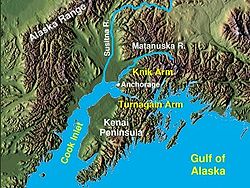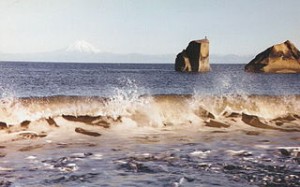We were sitting at anchor in a small cove on the coast of Kalgan Island waiting for the storm to break and listening to the radio. Somehow, Terry had managed to get a hold of one of the Dobenspeck Cannery secret maps. We were independent fishermen, meaning that we were beholding to no cannery, could sell to whomever we pleased, but as a consequence, not entitled to one of those maps.
The maps broke Lower Cook Inlet into sections and numbered them. Fishermen who worked exclusively for Dobenspeck Cannery of Kenai could communicate with one another concerning location, weather conditions, presence or absence of fish, etc. without giving away their location. How Terry had acquired the map I’ll probably never know, but we were listening intently to the jabber and closely scrutinizing the map.

Neither of us had ever commercial fished before. I was between my Junior and Senior years at Anchorage High School. Terry was a teacher in the Anchorage School District, as was his wife Dean Anne and my mom and dad. It wasn’t uncommon for teachers to venture into fishing back then. You didn’t have to deal with the present permit system, it was cheaper to get equipped and, of course, teachers had the summer off. Terry had approached me in the spring about being his deck hand for the summer. I was excited at the prospect and my parents thought it would be a good experience for me. Pay was to be something like $400.00 to $500.00 per month, room and board and a percentage of the catch if we made money.
Presently, the radio clattered and some guy on the Kenai side of the inlet started talking about how it was flattening out over there and he was in the middle of a school of “jumpers”. Fishermen keep an eye out for “jumpers” because it generally indicates a school of salmon. Also, back then we didn’t have much in the way of sophisticated electronic equipment. The fish don’t have a chance today!
If you were a seiner and had located a school of salmon you’d try to encircle the school and scoop them in with your power wench. If you were a gill netter you’d simply try to stretch your three shackles of net out in front of their path. The Wild Duck was a gill netter and the only power it had was a roller on the stern that was no help at all, its engine, one man and one boy…no power wench. The three shackles of gear acted as a sea anchor, so you didn’t really pull the net to the boat. You pulled the boat up to the net, hauled it over the stern and into the hold.
The Wild Duck was a 32 footer and as fast as any bow picker. It had, so the story went, been one of two of its type used by a preacher in Southeastern as a rum runner during Prohibition. It was a substantial boat and pulling in the gear by hand, fish flopping or not, was damned hard work, especially in rough weather.
Clatter, clatter and more talk about “jumpers” on the other side of the inlet. Terry couldn’t stand it. If there were fish to be caught he wanted to be in on the action. It wasn’t turning out to be a very good season for him and he no doubt had a bank payment to make. So, we ( I ) hauled anchor and we headed off into the inlet towing what I swear was the world’s heaviest skiff.
We got out to the first rip tide and it was rougher than a cob. There are three rip tides in Cook Inlet and the middle one is the worst. Terry didn’t want to try to turn around because he was afraid of losing the skiff and of taking a hold full of water on the maneuver, which could have swamped us. So he secured the steering wheel and came aft to help me pull the world’s heaviest skiff over the stern. When on board, it covered most of the deck. Terry returned to piloting the boat while I went about trying to secure the skiff. By now the Wild Duck was getting close to the middle rip tide and I was frantic to get the skiff secured. I swear, I fell once, having nothing to hang onto but the skiff, which was not as yet secured!
Cook Inlet is a shallow body of water and the rip tides are a confusion of water. They act like a magnet, dragging in all manner of debris. Add bad weather and you’ve got a very unpleasant and unhealthy set of facts.
There was no uniformity of direction to the waves that were upwards of 20 feet between trough and crest so we were being pummeled from every direction. We would get picked up 20 feet and the water beneath us would simply disappear and the boat would free fall, crashing to the bottom of the trough. There were logs as large as telephone poles flying through the air. Had I understood how perilous our situation was at the time I’d probably have been paralyzed with fear.
Terry screamed over the roar for me to go down into the cabin and try to get things under control. Right! One moment I’d be against the ceiling with every pot, dish, bottle and miscellaneous utensil in the cabin and the next moment I’d be groveling on my hands and knees on the floor with the same items. Lord knows how we made it across or how long it took. Several small boats went down in that storm with total loss of life.

When we had anchored again in the Kenai River, not being much in the mood for fishing after our high-adventure crossing, Terry broke out a couple of beers and we just looked at each other and laughed through the beer spray that covered both of us. The rest of the summer wasn’t as exciting, but it was wonderful. Fishing for a living and being on a boat for weeks on end has a touch, smell and texture of its very own.
The hard work filled me out physically, speeding my development into manhood and I learned a lot from the many discussions with Terry. He didn’t talk much about WWII, but he had a limp in one leg from an injury in Italy. His war experience had certainly shaped his outlook on life. He wasn’t cynical. He was simply very realistic. He had his own world view and not much escaped his observation. I remember once we were in some philosophical discussion and I used a quote from the Bible to prove my point. He said: “You mean to tell me you believe that!?”
My face turned red and I didn’t know what to say. The carpet had been pulled from beneath my feet. I was more astonished that I had accepted all that time something on pure faith without questioning it than I was shocked about what Terry had said.
Terry also convinced me that I needed some basic education that I didn’t have in order to survive out there where there was likely to be no help. I ended up taking a course in chemistry the next semester that I would not otherwise have taken.
Anyway, the rest of that season we set nets, hauled in fish, delivered them to tenders, mended nets, at which I got pretty good (start with a little hole…end up with a big one), dug clams (we ate so many razor clams I never wanted to set eyes on one again), poked around Cook Inlet (Seldovia before the earthquake was the most beautiful and interesting place I had ever seen, built entirely on a boardwalk as it was), and occasionally visited the city of Kenai, which wasn’t a big deal for me because I was too young to go to the bars and that’s all there was there.
At the end of the season we motored back to Anchorage, took the Wild Duck out of the water and completely went over her from bow to stern. We re-caulked her, repainted her inside and out, put new fiberglass with sand in it on her bow, scraped the bilge and prepared her for sale, which did not take long. She was a beautiful boat.
I don’t know whether it was the experience of the storm or the poor fishing season that caused Terry to sell the Wild Duck, but it certainly wasn’t that he hadn’t enjoyed the experience. Years later, whenever I’d run into Terry at a cocktail party or anywhere else the conversation eventually turned to the Wild Duck and our summer together on Lower Cook Inlet… and that damn secret map that nearly got us killed.
For more stories of Anchorage history, check out growingupanchorage.com.
I was born in Ft. Pierce, Florida, moved to Alaska in 1953, graduated from Anchorage High School and earned a Bachelor's degree in Political Science with a Minor in Philosophy at the University of San Francisco. I played alto saxophone in the Anchorage High School band, as well as ice hockey through high school and as a freshman at the University of Alaska Fairbanks before moving on to USF. Incidentally, I completed the seventeen credits I needed to graduate from USF in the Spring of 2011, 48 years late and earning a 4.0 gpa for the semester!
I have been a member of the Anchorage City Council and Anchorage Borough Assembly before unification, twice a board member of the Alcoholic Beverage Control Board, State of Alaska, and twice its Chairman. I have been on many boards, including Boys and Girls Clubs of Alaska, Anchorage Opera, Anchorage Repertory Theatre, Anchorage Mental Health Association and Boys Scouts of America, Western Alaska Council. I am an active Rotarian and past president of Anchorage Downtown Rotary.
My interests are climbing, running, skiing, scuba diving, reading, writing, traveling and opera. I have climbed six of the seven highest mountains on each of the continents and made three attempts on the seventh, Mt. Everest, reaching 27,500 ft. at age 50. I have also run fifteen marathons, including the original run from Marathon to Athens.
I have a son, Michael, a daughter, Michele, and seven grandchildren by my first wife. My present wife and I will celebrate our 26th anniversary in September 2012.




